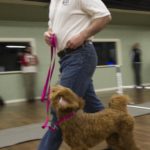Loose-Leash Walking (Abstract)

November 15, 2013
To most effectively and most humanely address any dog training or behavioral problem, we wish first to diagnose the origin of the behavior. Pulling on leash is most commonly caused by:
1) General excitability,
2) General under-stimulation,
3) Excitability or arousal directed toward or emanating from a specific stimulus,
4) Dominance,
5) Lack of knowledge regarding walking protocol, or
6) A thigmotactic (opposition) reflex.
Optimally, to best improve your dog’s walking behavior, we need to treat the preceding causal factors while concurrently addressing the walking behavior as a symptom.
We recommend addressing general excitability, under-stimulation, stimulus arousal, and dominance causations via behavior modification programs that include proactive stimulation, dog day care, nutrition adjustment, impulse control training, leadership training, environmental modification, cognitive behavioral drills, counterconditioning/desensitization drills, management restrictions, and/or anti-anxiety medication.
We recommend addressing causations involving lack of knowledge on the part of the owner or dog and/or tight-leash prompted thigmotactic reflex reactions by instituting leash walking procedures that provide consistently correct mechanics and communication.
When teaching proper leash walking behavior, insist that your dog remain in heel position, with his right shoulder alongside your left leg. Keep your leash loose and praise appropriately for the correct behavior. To assist your objectives, lure him with food and reward him when he looks upward attentively.
In many cases you may need to also incorporate mild leash response blocking techniques. In more refractory cases, you will need to properly select and fit an appropriate training collar and switch to a leather leash. Usually, pinch collars and Gentle Leaders are the most effective collar choices when teaching loose-leash walking. However, some dogs may need the third option, a no-pull harness. In addition, start in a quiet, low-distraction location absent of other people and dogs, then progress to more challenging higher distraction environments only after your dog is confident and routinely successful in the easier locales.
If all goes according to plan, your dog will calmly and cooperatively walk on a loose leash. Subsequently, both you and your dog will receive more pleasure and bonding from your neighborhood walks. Moreover, when you begin to receive more enjoyment from your walks, you will probably walk your dog more, which increases your dog’s quality of life.
Nevertheless, loose-leash walking is often a complex behavior that is difficult to resolve without the services of a professional trainer or behaviorist. Therefore, we recommend the inclusion of a CPT group class, private lesson, in-home private lesson, or board training program to raise the probability of success and/or to expedite results. To schedule a CPT training program, please contact the CPT office by phone at 404-236-2150 or contact us by e-mail via the Contact link at the top right of this web page.
© Copyright Mark Spivak and Comprehensive Pet Therapy, Inc., May 2010, Revised February 2014. All rights reserved.


